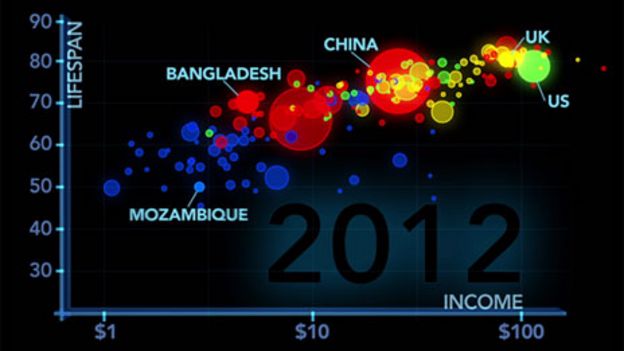Receive Daily Updates
Many people don’t know about the enormous progress most countries have made in recent decades – or maybe the media hasn’t told them. But with the following five facts everyone can upgrade their world view.
1. Fast population growth is coming to an end
It’s a largely untold story – gradually, steadily the demographic forces that drove the global population growth in the 20th Century have shifted. Fifty years ago the world average fertility rate – the number of babies born per woman – was five. Since then, this most important number in demography has dropped to 2.5 – something unprecedented in human history – and fertility is still trending downwards. It’s all thanks to a powerful combination of female education, access to contraceptives and abortion, and increased child survival.
The demographic consequences are amazing. In the last decade the global total number of children aged 0-14 has levelled off at around two billion, and UN population experts predict that it is going to stay that way throughout this century. That’s right: the amount of children in the world today is the most there will be! We have entered into the age of Peak Child! The population will continue to grow as the Peak Child generation grows up and grows old. So most probably three or four billion new adults will be added to the world population – but then in the second half of this century the fast growth of the world population will finally come to an end.

2. The “developed” and “developing” worlds have gone
Fifty years ago we had a divided world.
There were two types of countries – “developed” and “developing” – and they differed in almost every way. One type of country was rich and the other poor. One had small families, the other large families. One had long life expectancy, the other short. One was politically powerful, the other was politically weak. And between these two groups, in the middle, there was hardly anyone.
So much has changed, especially in the last decade, that the countries of the world today defy all attempts to classify them into only two groups. So many of the formerly “developing” group of countries have been catching up that the countries now form a continuum. From those nations at the top of the health and wealth league, like Norway and Singapore, to the poorest nations torn by civil war, like DR Congo and Somalia, and at every point in between, there are now countries right along the socio-economic spectrum. And most of the world’s people live in the middle. Brazil, Mexico, China, Turkey, Thailand, and many countries like them, are now in most ways more similar to the best-off than the worst-off. Half the world’s economy – and most of the world’s economic growth – now lies outside Western Europe and North America.

3. People are much healthier
Fifty years ago, the average life expectancy in the world was 60 years. Today it’s 70 years. What’s more, that average of 60 years in the 1960s masked a huge gap between long lifespans in “developed” and short lifespans in “developing” countries.
4. Girls are getting better education
The better education of girls is just a first step on the long road to gender equity. But sadly it is also changing the character of gender inequity. Violence against young women and restrictions on their rights to choose how to live their lives are now replacing lack of schooling as the main gender injustice.
5. The end of extreme poverty is in sight
What is “extreme poverty“? Economists define it as an income of less than $1.25 per day. In reality, it means that a family cannot be sure from one day to the next that they will have enough to eat.
Children have to work instead of going to school. Children die from easily preventable causes such as pneumonia, diarrhoea and malaria. And for women it means uncontrolled fertility and families of six or more children.
But the number of people in extreme poverty, according to the World Bank, has fallen from two billion in 1980 to just over one billion today. Though many people in the world still live on a very low income, six out of seven billion are now out of extreme poverty and this is a critical change. These families have fewer children, of whom the vast majority survive, get enough food and go to school.
In fact, for the first time ever, the evidence suggests it is now possible for the last billion to also get out of the misery of extreme poverty in the next few decades. It will mainly be through their own hard work – but it will only happen if they receive, from their governments and from the world at large, the focused help they need to stay healthy, get educated and increase their productivity.
Note:- We gave an Essay in our E02 essay test -“Will we be leaving the world a better place than we found it ? ” and this article can help give positive spin to the essay. Although the essay also requires one to write on the negative aspects as well- such as 300% increase in terrorism compared to last decade, Environmental degradation and increase in violence against women and many other issues.


